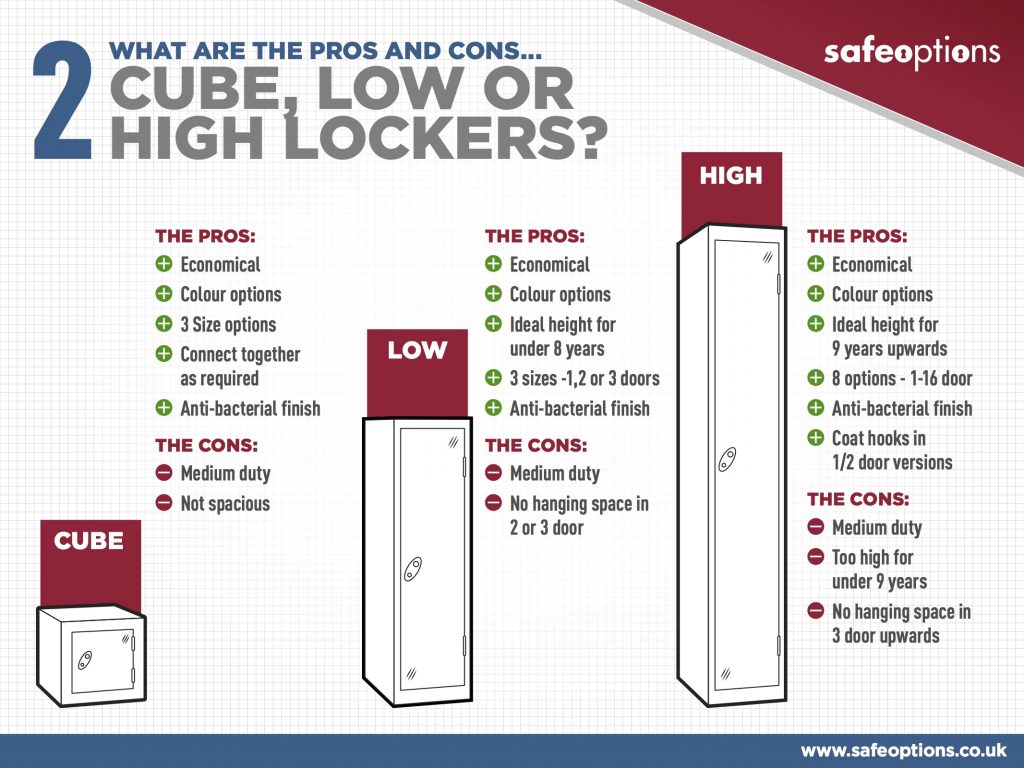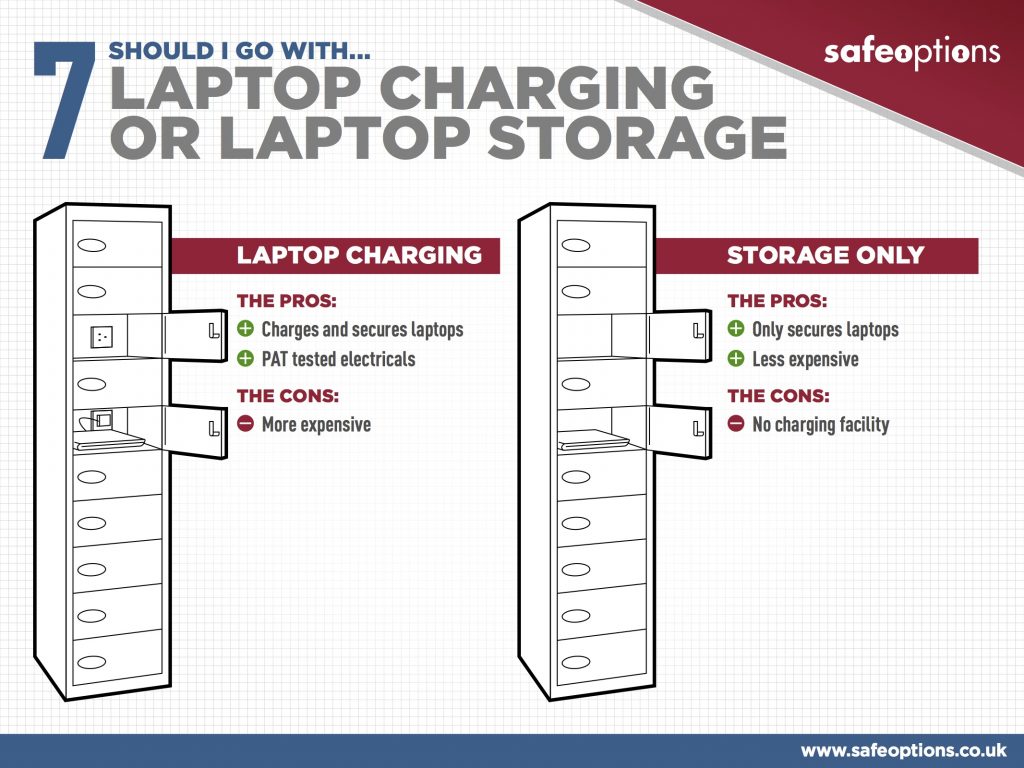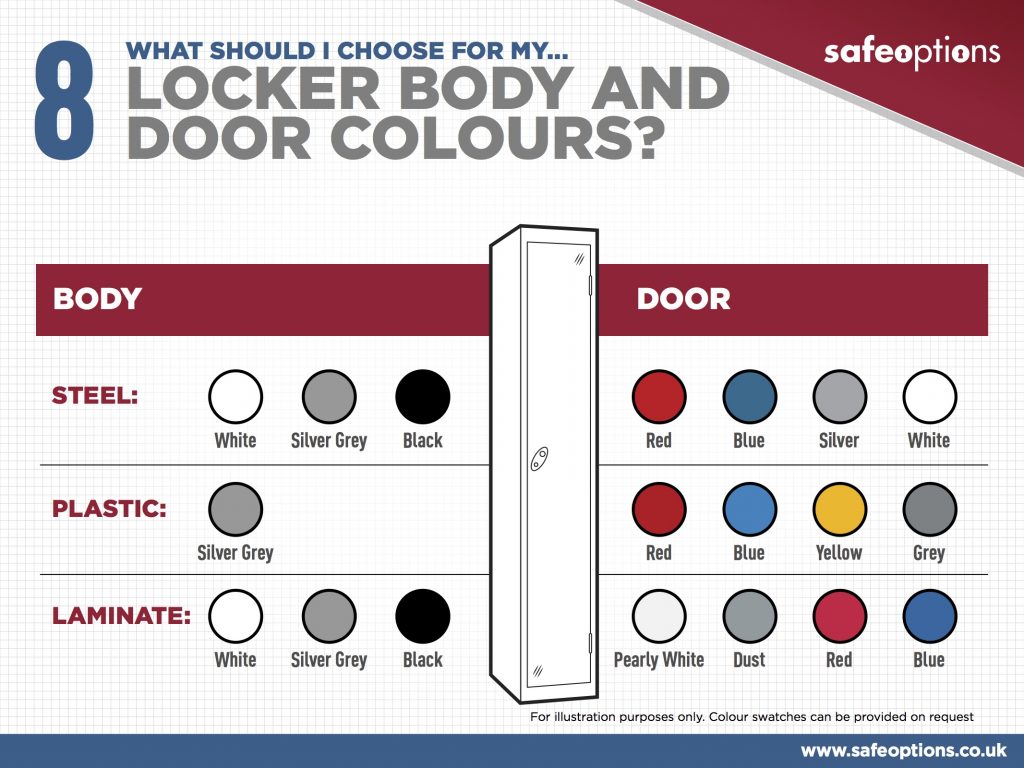Are you buying new school lockers? There’s a lot of choices, so we’ve explained the main options to help you decide what you need.
We sell a broad range of great school lockers by leading manufacturer Probe. They come in a variety of materials, sizes, colours and designs, so here’s our guide to choosing the right option for your school.
Your nine things to consider are:
- What Material – Plastic, Laminate or Metal?
- What Size – Cube, Low or High Lockers?
- How many compartments should they have?
- Do We Need Flat Tops or Sloping Tops?
- Are 1 Or 2-Person Lockers Best?
- What’s The Difference Between Inset And Overlay Doors?
- What’s The Benefit of Laptop Lockers?
- What Colour Lockers Can We Get?
- Which Type Of Locks Would Be Best?
1 - What Material – Plastic, Laminate or Metal?
 Which Locker is best for our school? Plastic, Laminate or Steel?
Which Locker is best for our school? Plastic, Laminate or Steel?
Where will your lockers live? If you need them to be damp or water-resistant, we recommend choosing plastic lockers. The Probe Ultrabox Plus range are fully waterproof, suitable for use in the playground.
Metal (steel) lockers are the traditional choice for a school locker room. They allow a lot of flexibility when it comes to size, shape, colour and configuration. An extra advantage of Probe’s steel doors is that they can be coated with an antibacterial layer effective against MRSA, E.Coli and other harmful bugs - ideal for reducing the spread of illness around a school. Steel doors are secure, but a good kick can still dent them or have graffiti scratched into them.
Laminate doors are a more hard-wearing option that makes sense for many schools. They’re a little more expensive but they can’t be scratched or dented and can withstand years of rough treatment. They look smart too.
2 - What Size – Cube, Low or High Lockers?
 Cube, perfect for infants. Low, perfect for under 8-year-old. High sized lockers perfect for all ages and teachers.
Cube, perfect for infants. Low, perfect for under 8-year-old. High sized lockers perfect for all ages and teachers.
The first thing to consider is how much stuff your students need to store. For primary schools, or where students only need to store a school bag or some books, cube lockers are the ideal size. You can stack and arrange them however you like.
High lockers are a good way to get lots of vertical storage space (including hanging space) without taking up too much floor area. You might need to think about whether smaller children would be able to reach the top shelf.
Low lockers are somewhere in between – more storage space than cube lockers, less than high lockers. You can fit even more lockers into a small space by stacking these in twos.
3 - How Many Compartments Should They Have?
 What is the objective? Store large items for fewer students or store small items for multiple students?
What is the objective? Store large items for fewer students or store small items for multiple students?
If you don’t think each student needs all the vertical storage space of a high locker, you can buy lockers split into up to 16 compartments, one for each student. It’s like having lots of smaller lockers, saving you space at the school. Bear in mind that smaller compartments for each student means no space for them to hang a coat or to store big items like sports equipment.
4 - Do We Need Flat Tops or Sloping Tops?
 Hygiene or extra storage; What's your school's goal?
Hygiene or extra storage; What's your school's goal?
It’s a small extra expense, but it might be worth it to fit sloping tops to your school lockers to prevent rubbish and lost items getting thrown on top of them. On the other hand, you might value the extra storage space on top of flat-topped lockers.
5 - Are 1 or 2-person Lockers Best?
 How much floor space do you have? This will answer the question about 1 or 2-person locker.
How much floor space do you have? This will answer the question about 1 or 2-person locker.
Sometimes, a 2-person locker takes up the same amount of space as a 1-person locker. 2-person lockers are split in half so that two people use half of the locker each. This is a good way to save space in your locker room, but each student has less storage space.
6 - What’s the Difference Between Inset and Overlay Doors?
 What is your maintenance budget for safes? This is a serious consideration when choosing Inset or Overlay doors.
What is your maintenance budget for safes? This is a serious consideration when choosing Inset or Overlay doors.
You’re probably used to seeing inset locker doors – the steel frame is visible around the door. You can get the frames and doors in matching colours for a more stylish look.
With overlay doors, the door hides the framework to create a smart finish, especially if you’re installing a wall of lockers. They’re a little less secure as they’re easier to prise open.
7 - What’s the Benefit of Special Laptop Lockers?
 Are charging hubs available around your school? How long are your school laptops lasting charged? These are questions to consider when choosing Laptop Storage.
Are charging hubs available around your school? How long are your school laptops lasting charged? These are questions to consider when choosing Laptop Storage.
There are some excellent reasons to invest in purpose-built laptop lockers to store class laptops or IPads overnight or between lessons. Firstly, each laptop can be securely locked away. There’s a separate compartment for each notebook, so they won’t be damaged by being stacked on top of each other. An empty compartment helps you quickly spot when someone hasn’t handed in their iPad. Rear perforated panels prevent laptops overheating. And some laptop lockers come with fitted charging points too, so that you can leave devices charging in safety.
8 - What Colour Lockers Can We Get?
 What are your school colours? There are more locker colour options depending metal, plastic or laminate.
What are your school colours? There are more locker colour options depending metal, plastic or laminate.
Locker doors come in a range of colour options, and the steel bodies can be a stylish white or black as well as the regular silver-grey. You might want to create a colourful wall of different coloured doors (this is especially easy to do with plastic cube lockers), or a tasteful room full of lockers that go with your paintwork. See the slide for the commonly-available colours.
9 - Which Type of Locks Would Be Best?
 Most caretakers gripes revolve around locker locks. Selecting the correct option can reduce wasted hours repairing locks.
Most caretakers gripes revolve around locker locks. Selecting the correct option can reduce wasted hours repairing locks.
There are four types of locks you can use for school lockers:
- key locks;
- padlock hasps;
- coin/token operated locks;
- or combination locks.
The slide above summarises the pros and cons. Key locks and combination locks share the disadvantage of students being able to lose and forget things – either their key or their code. But they both have the advantage of a master key that a member of staff can use in these situations. You won’t have to buy new keys in the case of combination locks, as they can simply be reprogrammed – but the locks cost more initially.
You can ask students to bring their own keys and padlocks if you choose padlock hasp lockers. This puts the responsibility into their hands, but might result in the caretaker having to cut off padlocks when keys get lost.
Make a Good Choice
It’s great that there’s a lot of choice in school lockers; it means you can kit out your school with the right facilities without having to compromise on space or security. So before you place an order, think about the amount of space you have, what items your students need to store, how durable or waterproof you need your lockers to be, what you'd like them to look like, and what type of locks you want to issue your students with. The information above should help you choose the right features for your new school lockers bearing all those factors in mind.
Give us a call to discuss your school locker requirements.
Please get in touch for more advice or to place an order. Call Freephone 0800 567 7549 or email us – our experts are always happy to help.



